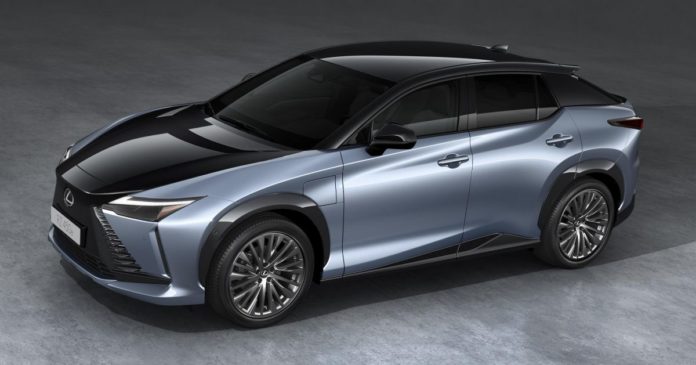Toyota and Lexus have built electric vehicles before, but the Toyota bZ4x and Lexus RZ are their first vehicles on the new dedicated electric e-TNGA architecture.
With Toyota a mass-market brand and Lexus the automaker’s luxury spinoff aimed at the German triumvirate of Audi, BMW and Mercedes-Benz, these two vehicles are positioned significantly differently in the market.
The bZ4x is almost indistinguishable from the related Subaru Solterra, but greater effort was required in styling the RZ in a way to appropriately distinguish it from its more affordable counterpart.
Exterior – front
Being powered by an electric motor, the bZ4X requires significantly less cooling than an internal combustion engined counterpart and, in turn, this has allowed Toyota to remove the front grille, instead designing a uniform, single-piece front bumper.
Toyota calls this a ‘brand-defining hammerhead shape that is smart and avoids unnecessary decoration’, and it puts the focus on the slim headlamps, with horizontally oriented LED DRLs that are connected by a chrome strip.
This also helps to visually widen the car, and draw a bystander’s eye to the use of matte black plastic used to cover the bZ4X’s front wheel arches.
Although matte black plastic wheel arches are now common in SUVs and have a further purpose in protecting the rest of the bodywork from scratches and debris, Toyota has taken this concept one step further and attempted to enhance the bZ4X’s rugged image by also extending them to the front wings, just below the headlights.
Recently, Lexus models have been defined by the brand’s iconic hourglass spindle grille and, to preserve the brand’s distinct identity, Lexus had the challenging task of retaining this design motif in a car that doesn’t need a front grille.
Instead, the RZ uses a combination of contours emanating from the bonnet, and contrasting paint options, to mark out a ‘closed-off’ interpretation of the spindle grille. Lexus calls this the first example of its ‘Next Chapter’ design language, which emphasises the ‘seamless E-motion’ of the electric powertrain underneath and transforms the spindle grille into a three-dimensional ‘spindle body.’
This means that for the front profile, Lexus has added strong creases to the car’s bonnet that converge into an hourglass shape at the front of the car. This is also distinguished by blacking out the areas underneath the headlights to create a spindle shape, or optionally leaving these areas in body colour but painting the bonnet and an hourglass shape on the front profile in black to create the same spindle effect.
Exterior – side profile
While the side profile of both cars is fundamentally similar, the differences remain in the details.
Lexus, perhaps to remain consistent with design themes established with sibling models such as the larger RX and the NX, has adopted a contrast floating roof design, with the availability of a black roof, and A, B, C and D pillars always painted in black, to visually lower the car and create a sleeker appearance.
Apart from two strong character lines above the door handles, including a Lexus RX-mimicking upwards kink towards the edge of the rear door, the rest of the side profile remains relatively smooth and conventional, perhaps a slight departure for Lexus which also has models such as the UX in its portfolio that feature a litany of body lines.
In an effort to arguably reflect its more rugged aspirations, the bZ4X features a semi-floating roof design, with a much stronger D pillar and a more aggressive character lines along the side profile to complement the greater use of cladding around the wheel arches.
In particular, the use of three distinct character lines, including one that kicks upwards into the rear wheel arch, conveys a greater sense of toughness than the smooth and sleek approach favoured by the RZ.
Exterior – rear
Both the bZ4X and the RZ feature full-width light bars, but there remain noticeable differences in the treatment of the tail-ends of both vehicles.
The bZ4x has a blockier design with emphasis also placed on the vertical axis through the use of a diagonal black plastic piece. This extends from the lower tail light into the rear-three quarters of the car. There’s also a large matte-black plastic rear bumper.
In contrast, the Lexus RZ features a much more ‘coupé SUV’ silhouette with a slimline rear light-bar and integrated ducktail rear spoiler that almost apes the BMW X4 in particular, while also drawing from the X6.
The rear bumper has a gloss, rather than matte, black finish, and the overall design emphasises the horizontal axis much more than the tougher bZ4X design.
Interior design
Lexus must differentiate its models from their Toyota cousins through a more premium, luxurious interior, and the RZ is no exception, as evident in its design and the materials used.
The prestige marque has recently tried to put further distance between itself and its Toyota counterpart, as well as European competitors, through the use of what Lexus calls its Tazuna driving cockpit. This is said to emulate the closeness of a horse and its rider, and as a result the RZ interior is more driver focused than its bZ4X counterpart.
This is evidenced by a larger infotainment display that is angled toward the driver, an instrument cluster positioned ergonomically behind (not above) the steering wheel, and a sportier dashboard design that appears to wrap around the driver while still providing the front passenger with adequate comfort.
Materials also benefit from an upgrade over the bZ4X, as demonstrated by an absence of piano black plastic along the centre console, and more premium door trims and steering wheel.
The bZ4X, in contrast, features a much more straightforward design, with the smaller infotainment display not angled toward the driver.
Notably, both the RZ and bZ4x offer the option of a steering yoke.
MORE: Everything Toyota bZ4x







